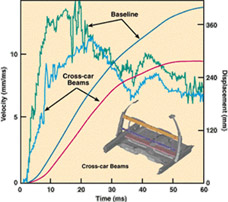Researchers designing the cross-car beam needed to answer a number of questions, not the least of which was, "What shape should it take?" Initially, they designed a beam that started at one B pillar, then bent back to accommodate the seating position of the driver and passenger, then bent forward to meet the other B pillar.
"I did a simulation and determined that this configuration
didn't absorb energy in a side impact; it just buckled," says
Chin-Hsu Lin, Senior
Research Engineer in the Occupant Safety Systems group of
the Vehicle Analysis & Dynamics Lab. "We realized thought
we needed to strengthen the beam, so we changed the geometry
to straighten it. But it still buckled.
"Imagine that you have a long ruler in your hands and you compress it. Even if it's straight, it just bends. So we needed to design a crush initiator - a portion of the beam that's weaker, so it's easier to crush at that point than to bend at that point."
Ultimately, that's the configuration the cross-car beam took. The researchers decided to use a tube design that would allow the beam to stroke, with one section moving inside the other. If the force acting on the beam in a crash is less than 10 kN, the beam will remain intact. If the force is larger, one section will plow through the other with a resistant force of 10 kN. The force is carefully tuned so that the beam always remains straight, a key to ensuring the occupants' safety.
To simulate the various geometries, Lin used LS-DYNA3D software and concentrated on two main parameters: structural intrusion and the velocity of the door coming toward the driver. As Figure 3 shows, the final design for the cross-car beam reduced the B-pillar intrusion from 407 mm to 281 mm (31 percent or about 5 inches) and the door intrusion from 269 mm to 209 mm (22 percent or almost 2.5 inches) - while also reducing the rate at which the intrusion occurred. Clearly, the cross-car beam is an innovation with the potential to make vehicles much safer for occupants in side impacts.
| Analysis |
B-pillar Intrusion (mm) |
Door Intrusion (mm) |
| Baseline |
406.7 |
268.6 |
| Cross-car Beams |
281.3 (-30.8%) |
209.4 (-22.0%) |
Figure 3. Cross-car Beam Analysis
By Diane Kightlinger
Safety Car Showcases Team Innovation
Analysis of the Bumper





